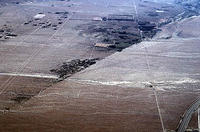-
A boom in global natural gas, by itself, will not slow climate change
A new analysis of global energy use, economics, and the climate shows that without new climate policies, expanding the current bounty of inexpensive natural gas alone would not slow the growth of global greenhouse gas emissions worldwide over the long term. Because natural gas emits half the carbon dioxide of coal, many people hoped the recent natural gas boom could help slow climate change — and according to government analyses, natural gas did contribute partially to a decline in U.S. carbon dioxide emissions between 2007 and 2012. In the long run, however, according to this study, a global abundance of inexpensive natural gas would compete with all energy sources — not just higher-emitting coal, but also lower-emitting nuclear and renewable energy technologies such as wind and solar. Inexpensive natural gas would also accelerate economic growth and expand overall energy use.
-
-
New facility for hurricane research to study why some storms intensify so quickly
It still astonishes meteorologists. In the span of just twenty-four hours, Hurricane Wilma, the twenty-second named storm of the record-breaking 2005 Atlantic hurricane season, intensified from a tropical cyclone to a Category 5 hurricane — its wind speed soaring from 70 to 175 mph. As remarkable as Wilma’s rapid intensification was, however, it is not the only case of a storm muscling up at warp speed. As Hurricane Charley approached Florida’s west coast in 2004, its sustained winds jumped from 110 to 150 mph in only three hours. In 2007 Felix strengthened from a meager tropical depression to a Category 5 hurricane in fifty-one hours. This could all change soon now that the University of Miami’s Rosenstiel School of Marine and Atmospheric Science has opened its Marine Technology and Life Sciences Seawater Complex, a $50 million facility that houses a 38,000-gallon, 75-foot-long tank into which researchers pump seawater to study how the ocean and atmosphere interact — the critical air-sea interface that could tell us why some storms intensify so quickly.
-
-
Floating cities increasingly attractive prospect in the face of sea level rise, floods

More and more urban planners and disaster managers are asking the question: “Has the time come for floating cities?” Experts say thatin the face of climate change-driven sea level rise and shifting weather patterns poised seriously to impact many cities over the course of the next decades, the option of having cities that can accommodate shifting tides is making more and more sense.
-
-
Hydraulic fracturing caused earthquakes in Ohio
Hydraulic fracturing triggered a series of small earthquakes in 2013 on a previously unmapped fault in Harrison County, Ohio, according to a new study. This series of earthquakes is the first known instance of seismicity in the area. Hydraulic fracturing, or fracking, is a method for extracting gas and oil from shale rock by injecting a high-pressure water mixture directed at the rock to release the gas inside. The process of hydraulic fracturing involves injecting water, sand and chemicals into the rock under high pressure to create cracks. The process of cracking rocks results in micro- earthquakes.
-
-
Sections of the San Andreas Fault system in San Francisco Bay Area are locked, overdue

The earthquake cycle reflects the accumulation of strain on a fault, its release as slip, and its re-accumulation and re-release. Fault creep is the slip and slow release of strain in the uppermost part of the Earth’s crust that occurs on some faults between large earthquakes, when much greater stress is released in only seconds. Where no fault creep occurs, a fault is considered locked and stress will build until it is released by an earthquake. Four urban sections of the San Andreas Fault system in Northern California have stored enough energy to produce major earthquakes, according to a new study that measures fault creep. Three fault sections — Hayward, Rodgers Creek, and Green Valley — are nearing or past their average recurrence interval, according to the study.
-
-
In worst-case scenario, sea level would rise 1.8 meters
The climate is getting warmer, the ice sheets are melting and sea levels are rising — but how much? The report of the UN’s Intergovernmental Panel on Climate Change (IPCC) in 2013 was based on the best available estimates of future sea levels, but the panel was not able to come up with an upper limit for sea level rise within this century. Now researchers have calculated the risk for a worst-case scenario. The results indicate that at worst, the sea level would rise a maximum of 1.8 meters – but the much more likely rise in sea level would be around 80 cm.
-
-
Bay Area’s infrastructure more resilient, but a major tremor would paralyze region’s economy
Twenty-five years ago, the San Francisco Bay Area suffered the 6.9 magnitude Loma Prieta earthquake, which killed sixty-three people, injured 3,700, destroyed 366 businesses and 11,000 homes, and caused $6 billion in property damage. Since then, bridges and roads have been rebuilt to withstand more powerful quakes, but seismic safety experts say more could be done to protect property and human life. A major earthquake is not likely completely to destroy the Golden Gate Bridge or other major infrastructure developments, but the Bay Area’s $535 billion a year economy will come to a halt for months and even years due to weakened critical infrastructure.
-
-
U.S. military must be ready for climate change: Hagel
Climate change is a threat multiplier, and the U.S. Defense Department is taking steps to incorporate this issue into all planning, Defense Secretary Chuck Hagel said in Peru Monday. Climate change has the potential to exacerbate many of the challenges the world already confronts, from the spread of infectious diseases to spurring armed conflicts, Hagel said at the Conference of the Defense Ministers of the Americas. Hagel announced a Defense Department Climate Change Adaptation Roadmap during his speech. The roadmap is based on science, he said, and describes the effects of climate change on DoD’s missions and responsibilities.
-
-
15 years from now, our impact on regional sea level will be clear

Coastal communities and industries require information on regional sea-level change to develop strategies for reducing the risk to population, infrastructure and the environment. This requires modeling projections of sea-level rise, estimating the costs and benefits of adaptation options, and understanding the impacts on coastal ecosystems. Inundation maps that can be used to identify areas that are most vulnerable to rising sea levels are particularly valuable. Adaptation measures may include land-use planning such as preventing building in low lying areas, increasing or maintaining a vegetated coastal margin that serves as a buffer zone against extreme sea levels, or using protective sea walls in the long run if certain sea level rise thresholds are exceeded.
-
-
Simulations reveal California’s resilience to extreme droughts
The results from a series of several-year-old computer simulations reveal that the state of California may be more resilient to long-term drought conditions than previously believed. “The results were surprising,” said one of the scientists involved in the study. “California has a remarkable ability to weather extreme and prolonged droughts from an economic perspective.”
-
-
U.S. should emulate allies in pushing for public-private cybersecurity collaboration
Israeli Prime Minister Benjamin Netanyahu announced last month the formation of a national cyber defense authority to defend civilian networks under the leadership of the Israel National Cyber Bureau.The “U.S. government has a lot to learn from successful examples in allied nations. With more compromise and reform, there is plenty of reason for hope,” says a cybersecurity expert, adding that “a cybersecurity partnership between government, business, and individuals built on trust is possible, and would promote more resilient networks as well as creative thinking on cybersecurity.”
-
-
Debate continues over releasing Pennsylvania crude oil shipment information
Shipment of crude oil by rail in the United States has increased from 800,000 barrels a day in 2012 to 1.4 million in 2014. In western Pennsylvania, over seventy-five million gallons of crude oil are passing through Allegheny and Westmoreland counties to refineries in Philadelphia. Release of the recently classified rail transport records by Pennsylvania Emergency Management Agency (PEMA) was a result of a federal mandate ordering railway companies to share information on interstate shipments of crude oil with state emergency management officials.Railway companies claim that releasing the information threatens security and is commercially sensitive.
-
-
Some states are better prepared than others for climate change challenges
In recent years, a number of states have started taking action to prepare their communities for climate change. Many have even developed specific adaptation plans to guide their work. Until now, though, no one has been able to define how much progress states are actually making in implementing those plans. The Georgetown Climate Center’s (GCC) online tool, the State Adaptation Progress Tracker, changes that. A GCC release says that now, anyone will be able to quickly determine how much progress their state is making and decision-makers will be able to learn from innovative examples of actions other states are taking.
-
-
The likelihood of a California Big One “uncomfortably high”: Experts

Research on the San Andreas fault has shown that the average time between surface-rupturing earthquakes is about a century. Experts say that these findings are a call to action. The last two “big ones” on the San Andreas fault — in 1906 in Northern California and 1857 in Southern California — occurred more than a century ago. There are several ways to calculate the probability of a similar earthquake, but they all give uncomfortably high results. A large earthquake is likely in our lifetime. A magnitude 7.8 earthquake is realistic, one expert says. “Our data show that similar earthquakes happened here in the not-too-distant past. As Shakespeare said, past is prologue. However, past large earthquakes on the San Andreas fault affected very few people. Now millions are at risk.”
-
-
Reliance on BP, feeble regulations make U.S. partially culpable in Deepwater Horizon oil spill
A recent ruling by a federal judge that BP was “grossly negligent” in the 2010 Deepwater Horizon oil rig spill in the Gulf of Mexico placed the majority of blame on the multinational oil and gas company. Although not on trial in this case, the federal government was also culpable in the largest oil spill in U.S. history, according to a new paper. Based on reports from the National Commission on the BP Deepwater Horizon Oil Spill and Offshore Drilling, the Chief Council’s Report and other government documents, the report’s authors determined that the government’s reliance on market-based accountability mechanisms and its failure to implement a regulatory process based on a mutually agreed upon set of robust standards and voluntary information disclosure led to the largest oil spill in U.S. history.
-
More headlines
The long view
Helping Strengthen America’s Critical Infrastructure
Everyday life depends on a robust infrastructure network that provides access to running water, communications technology and electricity, among other basic necessities. The experts who keep our national infrastructure secure and resilient also need a strong network to share their knowledge and train the next generation of professionals capable of solving complex infrastructure challenges.
AI and the Future of the U.S. Electric Grid
Despite its age, the U.S. electric grid remains one of the great workhorses of modern life. Whether it can maintain that performance over the next few years may determine how well the U.S. competes in an AI-driven world.
Using Liquid Air for Grid-Scale Energy Storage
New research finds liquid air energy storage could be the lowest-cost option for ensuring a continuous power supply on a future grid dominated by carbon-free but intermittent sources of electricity.
Enhanced Geothermal Systems: A Promising Source of Round-the-Clock Energy
With its capacity to provide 24/7 power, many are warming up to the prospect of geothermal energy. Scientists are currently working to advance human-made reservoirs in Earth’s deep subsurface to stimulate the activity that exists within natural geothermal systems.
Experts Discuss Geothermal Potential
Geothermal energy harnesses the heat from within Earth—the term comes from the Greek words geo (earth) and therme (heat). It is an energy source that has the potential to power all our energy needs for billions of years.
